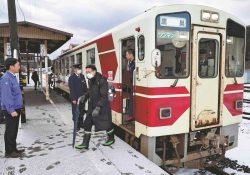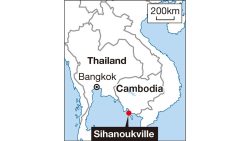Fukushima Nuclear Plant Debris Moved to Research Institute; Analysis Results to be Applied to Future Removal Efforts

Tokyo Electric Power Company Holdings, Inc.’s Fukushima No. 1 nuclear power plant
16:30 JST, November 13, 2024
Nuclear fuel debris taken out of the No. 2 reactor at the Fukushima No. 1 nuclear power plant has been transported to the Japan Atomic Energy Agency’s Oarai Nuclear Engineering Research Institute in Ibaraki Prefecture.
This is the first time that debris has been moved outside the premises of the nuclear power plant since the 2011 meltdown.
Beginning Thursday, the debris will be analyzed over about a year to determine its hardness and composition. The aim is to use the results to prepare for the full-scale removal of debris in the future.
On Tuesday afternoon, Tokyo Electric Power Company Holdings, Inc. transported the debris to the research institute by truck. It was carried in a lead container that blocks radiation.
The pebble-like debris, which was collected on Nov. 7, was about 5 millimeters in size and weighed about 0.7 grams. Previously, it had been stored in the reactor building.
Prior to transportation, the radiation level outside the lead container was measured and the figure was confirmed to be below the legal safety level.
The results of the analysis by the research institute and others will be used as a reference for examining methods and tools to be used in full-scale removal efforts, as well as methods for storing debris.
It will also help estimate the conditions inside reactors immediately after the accident. This will shed light on the processes that generate debris.
After the debris is analyzed, it will be stored again at the Fukushima No.1 nuclear power plant. However, the final disposal site for all the plant’s debris, which is estimated to be 880 tons in total at the Nos. 1 to 3 reactors, has yet to be decided.
Expectations high
The research institute has previously examined spent nuclear fuel and radioactive particles collected at the nuclear power plant. The latest debris will be analyzed by investigating the distribution of elements on the surface, by cutting and measuring it, and by dissolving it in nitric acid to determine its components.
The possibility is also being considered of sending the debris to the JAEA’s Nuclear Science Research Institute in Ibaraki Prefecture and two private organizations for analysis.
“Compared to the microscopic samples we have dealt with, this is a large enough sample,” said Koji Maeda, chief of the fuel materials development department at the Oarai Nuclear Engineering Research Institute. “We want to produce results that contribute to decommissioning.”
"Society" POPULAR ARTICLE
-

M4.9 Earthquake Hits Tokyo, Neighboring Prefectures
-

M7.5 Earthquake Hits Northern Japan; Tsunami Waves Observed in Hokkaido, Aomori and Iwate Prefectures
-

Tsukiji Market Urges Tourists to Avoid Visiting in Year-End
-

Beloved Cat Stationmaster Nitama in Wakayama Pref. Passes Away at 15
-

M5.7 Earthquake Hits Japan’s Kumamoto Pref., Measuring Upper 5 Intensity, No Tsunami Expected
JN ACCESS RANKING
-

Keidanren Chairman Yoshinobu Tsutsui Visits Kashiwazaki-Kariwa Nuclear Power Plant; Inspects New Emergency Safety System
-

Imports of Rare Earths from China Facing Delays, May Be Caused by Deterioration of Japan-China Relations
-

Japan Exports Rise in October as Slump in U.S. Sales Eases
-

Govt Aims to Expand NISA Program Lineup, Abolish Age Restriction
-

Blanket Eel Trade Restrictions Rejected






















